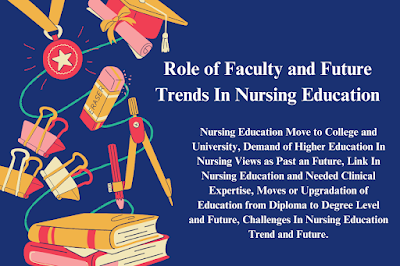Nursing Education Role of Faculty and Future Trends
Nursing Education Move to College and University
Over
time, as nursing education has moved from the service sector to college and
university campuses, the role of nursing faculty has evolved, becoming
increasingly complex. As higher education and the science of nursing has
developed, the effect on nursing education has been tremendous.
Demand of Higher Education In Nursing Views as Past an Future
Nursing
education is enmeshed in sweeping changes. The forces driving these changes are
numerous and difficult to isolate; they include the severe nursing faculty
shortage, the increasing multiculturalism of society, the decreasing financial
resources in education and health care, changes in the delivery of health care
through health care reform, the integration of evidence based practice and the
need for more nurses with higher degrees, expanding technology and the
accompanying knowledge explosion, the need for lifelong learning, a shifting
emphasis to learning instead of teaching, and the increasing public demand for
accountability of educational outcomes.
There
has been a call by the federal government and others to build more points of
student assessment into postsecondary education to provide evidence that
outcomes are being met in an effort to hold colleges and universities
accountable for the learning experiences they provide (Dwyer, Millett, &
Payne, 2006). These are just a few of the issues that educators must consider
as they fulfill the responsibilities of their role.
Link In Nursing Education and Needed Clinical Expertise
The need
to maintain strong clinical skills within the context of a continuing critical
shortage of nurses that is projected to last for decades have created an
additional challenge for nurse educators (Beck & Ruth-Sahd, 2013). The
requirement to maintain certification qualifications in their specialties is
another factor contributing to work strain for nurse educators.
In
addition to clinical certifications, nurse educators now have the additional
option of seeking credentialing as a certified nurse educator (CNE) through the
National League for Nursing's (NLN) Academic Nurse Educator Certification
Program (National League for Nursing (NLN), 2014).
This
additional affirmation of teaching expertise helps to close the widening
practice education gap. As of 2013, more than 3800 nurse educators had achieved
CNE certification (Hagler, Poindexter, & Lindell, 2014), and it is
estimated the number will reach 5000 by 2016.
Moves or Upgradation of Education from Diploma to Degree Level and Future
To meet
projected demands for registered nurses, nursing programs must increase their
graduation rates, especially for nurses with higher degrees (Institute of
Medicine [IOM], 2010; US Department of Health and Human Services, 2010).
According
to the American Association of Colleges of Nursing (AACN), 78,089 qualified
applicants were turned away from baccalaureate and graduate nursing programs
because of lack of available faculty and clinical resources (American
Association of Colleges of Nursing (AACN), 2014).
The
Future of Nursing report released by the Institute of Medicine (2010) issued a
call for a nursing workforce in which 80% of nurses will have a bachelor's
degree in nursing by 2020 as well as doubling the number of nurses prepared
with a doctorate.
At the
same time, the Tri-Council for Nursing (2010)—made up of the AACN, the American
Nurses Association, the American Organization of Nurse Executives, and the
NLN—reports a scarcity of prepared nursing faculty. Only one in four full-time
nursing faculty held a doctoral degree in 2009, whereas two-thirds were masters
prepared (Kaufman, 2010).
Challenges In Nursing Education Trend and Future
The
demand for more nurses in service settings with advanced degrees and a scarcity
of prepared nursing faculty have placed a tremendous burden on nursing
education and the faculty trying to meet the growing needs.
Nursing
education is in a crisis, overloaded by the demand to teach more students with
fewer faculty members. The faculty shortage is being exacerbated by the
projection that 500,000 nursing faculty will retire in the next 10 years
(Aiken, 2011).
Nearly
76% of full-time nursing faculty were older than 45 in 2009 (Kaufman, 2010).
According to the AACN, “The average ages of doctorally prepared nurse faculty
holding the ranks of professor, associate professor, and assistant professor
were 61.6, 57.6, and 51.4 years, respectively. For master's degree–prepared
nurse faculty, the average ages for professors, associate professors, and
assistant professors were 57.1, 56.8, and 51.2 years, respectively” (Nursing
In
addition to losing nursing faculty to retirements, faculty leave academia at an
alarming rate for other reasons. Factors identified that influence faculty
turnover include workload, demand for a tenure-track position, perceived lack
of collegiality, and noncompetitive salaries. Areas of satisfaction that
enhance faculty retention include faculty identity (autonomy and role),
research satisfaction, and sense of belonging to an academic community (Tracy
& Fang, 2011).
As
faculty in higher education face these challenges, they need to find new ways
to teach and implement their role. Benner, Sutphen, Leonard, and Day (2010)
call for a radical change in how nursing students are educated.
As a
result of their study of selected nursing programs, they concluded that nursing
programs have many deficits, including weak classroom pedagogy, failure to
integrate classroom and clinical content and experiences, and poor development
of Students' clinical reasoning and inquiry skills.
They
made 26 recommendations to transform nursing education, calling for a major
paradigm shift. Nursing faculty of the future will need to embrace innovation
and be advocates for change and forward movement if these goals are to be met.
This
Topic provides a brief historical perspective of the faculty role; outlines
future trends; identifies faculty rights and responsibilities; and describes
the process of faculty, appointment, and tenure (APT) within the current
context.
In addition, faculty development of the competencies related to teaching as a scholarly endeavor is discussed, and implications for change in the faculty role needed to meet current and future expectations and demands are addressed.




Give your opinion if have any.